Shrimp paste/ja: Difference between revisions
Created page with "ベトナムのシュリンプペースト(''マムトム''、{{IPA|vi|mam˧ˀ˦ tom˧|IPA}})には、とろみのあるペースト状のものと、より液状のソース状の2種類がある。提供する際は、通常、砂糖、ライムジュース、キンカン、唐辛子と混ぜてディッピングソースとして使用される。ベトナムでは、''マムトム''を茹で肉、揚げ豆腐、揚げ魚のディッピングソー..." |
Created page with "シュリンプペーストは、東南アジア以外の国でも、アジア系顧客向けの市場で手に入れることができる。オランダでは、コニマックス社の''Trassie Oedang''など、アジア食品を販売するスーパーマーケットでインドネシア風シュリンプペーストを見つけることができる。アメリカでは、''Pantainorasingh''や''Tra Chang''といったタイのシュリンプペース..." Tags: Mobile edit Mobile web edit |
||
| (10 intermediate revisions by the same user not shown) | |||
| Line 104: | Line 104: | ||
ベトナムのシュリンプペースト(''マムトム''、{{IPA|vi|mam˧ˀ˦ tom˧|IPA}})には、とろみのあるペースト状のものと、より液状のソース状の2種類がある。提供する際は、通常、砂糖、ライムジュース、[[kumquat/ja|キンカン]]、唐辛子と混ぜてディッピングソースとして使用される。ベトナムでは、''マムトム''を茹で肉、揚げ豆腐、揚げ魚のディッピングソースとして、または''[[bún mắm/ja|ブンマム]]''などのスープ料理の味付けによく使用する。 | ベトナムのシュリンプペースト(''マムトム''、{{IPA|vi|mam˧ˀ˦ tom˧|IPA}})には、とろみのあるペースト状のものと、より液状のソース状の2種類がある。提供する際は、通常、砂糖、ライムジュース、[[kumquat/ja|キンカン]]、唐辛子と混ぜてディッピングソースとして使用される。ベトナムでは、''マムトム''を茹で肉、揚げ豆腐、揚げ魚のディッピングソースとして、または''[[bún mắm/ja|ブンマム]]''などのスープ料理の味付けによく使用する。 | ||
===ンガピ・ヤイ{{Anchor|Ngapi yay}}=== | |||
===Ngapi yay=== | {{Main/ja|Ngapi/ja}} | ||
{{Main|Ngapi}} | ミャンマー、特にビルマ族やカレン族の間で非常に人気のある水っぽいディップまたは調味料。ンガピ(魚またはエビ、しかし主に魚全体のンガピが使用される)を玉ねぎ、トマト、ニンニク、コショウ、その他のスパイスと一緒に煮込む。その結果、緑がかった灰色のスープのようなソースができあがり、あらゆるビルマの食卓に並ぶ。新鮮な生野菜、湯通しした野菜、果物(ミント、キャベツ、トマト、青マンゴー、青リンゴ、オリーブ、唐辛子、玉ねぎ、ニンニクなど)をンガピ・ヤイに浸して食べる。時には、あまり裕福でない家庭では、ンガピ・ヤイが主菜となり、主要なタンパク源となることもある。 | ||
===プティス・ウダン{{Anchor|Petis udang}}=== | |||
===Petis udang=== | [[File:Petis.JPG|thumb|left|インドネシア、[[:en:Sidoarjo|シドアルジョ]]で生産された黒い''プティス・ウダン''の糖蜜のような粘度]] | ||
[[File:Petis.JPG|thumb|left| | |||
''プティス・ウダン''は、インドネシア、マレーシア、シンガポールで使われるシュリンプ/プラウンペーストの一種である。インドネシアでは特に[[East Java|東ジャワ州]]で人気がある。この濃厚な黒いペーストは、ブラチャンのような硬いレンガ状ではなく、糖蜜のような粘度がある。また、[[added sugar/ja|砂糖が加えられている]]ため、より甘い味がする。プティスは、エビ加工の残りかすのスラリーを煮詰めて作られる。一般的に、プティスに甘い風味を与えるために糖蜜が加えられる。これは、''[[popiah/ja|ポピア]]''春巻き、''[[Asam laksa/ja|アサム・ラクサ]]''、''チーチョンファン''米ロール、そして[[Rujak/ja#Rujak Cingur|''ルジャック・チンガル'']]や[[Rujak/ja#Rujak Petis|''ルジャック・プティス'']]などの[[rojak/ja|ルジャック]]サラダなど、地元の一般的な屋台料理の風味付けに使われる。インドネシアでは、[[:en:East Java|東ジャワ州]]の[[:en:Sidoarjo|シドアルジョ]]、[[:en:Pasuruan|パスルアン]]、[[:en:Gresik|グレシク]]地域にある家内工業が主な''プティス''生産者である。 | |||
'' | |||
===シドル{{Anchor|Sidol}}=== | |||
===Sidol=== | バングラデシュの[[:en:Chittagong Hill Tracts|チッタゴン丘陵地帯]]では、[[:en:Jumma people|ジュマ族]]がシュリンプペーストを''シドル''または''ナッピ''と呼んでいる。彼らはこれを使ってタケノコカレーなどの野菜料理を作る。この[[bamboo shoot/ja|タケノコ]]カレーは、[[:en:Jumma people|ジュマ族]]の伝統的な食べ物である。彼らはこの方法で食べる。まず、タケノコを竹林から集め、葉を取り除き、水で茹でる。次に、茹でた水とシュリンプペーストを混ぜる。シュリンプペーストを混ぜた水に、唐辛子、ニンニクペースト、塩、小麦粉を加える。混合物を加熱し、数分後、茹でたタケノコを混合物に乗せ、引き続き加熱する。数分後、料理は提供できる状態になる。 | ||
===テラシ{{Anchor|Terasi}}=== | |||
===Terasi=== | [[File:Trassie Poeder.jpg|thumb|right|オランダの粉末状の''トラシ'']] | ||
[[File:Trassie Poeder.jpg|thumb|right| | テラシ({{Langx|nl|trassi}}、{{Langx|jv|ꦠꦿꦱꦶ|translit=trasi}})は、インドネシア(特に[[:en:Java|ジャワ]])の乾燥シュリンプペーストの一種で、通常は暗いブロック状で売られているが、粗い粒状の粉末としても販売されることがある。テラシの色と香りは、どの村で生産されたかによって異なる。色は柔らかい紫赤色から暗茶色まで様々である。[[:en:West Java|西ジャワ州]]の沿岸都市[[:en:Cirebon|チレボン]]では、テラシは''レボン''と呼ばれる小さなエビ(''[[Acetes/ja|Acetes]]'')から作られ、これが市の名前の由来となっている。もう一つの種類は、エビやマグロをパームシュガーと混ぜて作られるプティスである。[[:en:Sidoarjo|シドアルジョ]]([[:en:East Java|東ジャワ州]])では、テラシは魚、小さなエビ(''ウダン'')、野菜などの材料を混ぜて作られる。テラシは、[[sambal|サンバル]]テラシの重要な材料であり、その他多くの[[Indonesian cuisine/ja|インドネシア料理]]、例えば[[sayur asem/ja|サユール・アセム]](タマリンド風味の野菜スープ)、ロテック([[gado-gado/ja|ガドガド]]とも呼ばれるインドネシア風ピーナッツソースサラダ)、カレドック(ロテックに似ているが、野菜は生で供される)、[[rujak/ja|ルジャック]](インドネシア風辛口[[fruit salad/ja|フルーツサラダ]])などにも使用される。 | ||
インドネシアの[[:en:Lombok|ロンボク島]]では、より風味豊かで甘いシュリンプペースト''レンカレ''が作られている。 | |||
==産業{{Anchor|Industory}}== | |||
= | [[Image:Shrimp.paste-hill tracts.jpg|thumb|upright|シュリンプペーストを販売する行商人]] | ||
[[Image:Shrimp.paste-hill tracts.jpg|thumb|upright| | シュリンプペーストは、現在も沿岸部の漁師の家族によって作られている。彼らはそれを[[:en:vendor|行商人]]、仲買人、または[[:en:Wholesaling|流通業者]]に販売し、彼らが消費者への再販のために包装する。シュリンプペーストは、製造技術と品質が村ごとに異なるため、産地で知られることが多い。インドネシアの[[:en:Riau|リアウ州]][[:en:Bagansiapiapi|バガンシアピアピ]]、[[:en:West Java|西ジャワ州]][[:en:Indramayu|インドラマユ]]、[[:en:Cirebon|チレボン]]、[[:en:East Java|東ジャワ州]][[:en:Sidoarjo|シドアルジョ]]などの一部の沿岸地域や、マレーシアの[[:en:Pulau Betong|プラウ・ベトン]]、香港の[[:en:Ma Wan|馬湾]]島、フィリピンの[[:en:Pangasinan|パンガシナン州]][[:en:Lingayen Gulf|リンガエン湾]]などの村は、非常に高品質なシュリンプペーストの生産でよく知られている。 | ||
==調製方法{{Anchor|Preparation}}== | |||
==Preparation== | 調製方法は大きく異なる場合があるが、中国や東南アジアの大部分では以下の手順が最も一般的である。 | ||
漁獲された小エビは、まず陸揚げされ、水洗いされて水気を切ってから乾燥される。乾燥は、地面に敷いたプラスチックマットの上で天日干しにするか、低い高床式の金属台の上で行うか、または他の方法を用いる。数日後、エビと塩の混合物は黒ずんで濃厚なパルプ状になる。ペーストの製造に使用されたエビが小さい場合は、個々のエビが認識できないほど分解されればすぐに提供できる状態になる。エビが大きい場合は、発酵に時間がかかり、パルプはより滑らかな粘度にするために粉砕される。この発酵と粉砕のプロセスは、ペーストが完全に熟成するまで数回繰り返されるのが一般的である。その後、ペーストは乾燥され、村人によってブロック状に切られて販売される。乾燥したシュリンプペーストは冷蔵を必要としない。 | |||
==入手性{{Anchor|Availability}}== | |||
==Availability== | [[Image:Trassie oedang.jpg|thumb|left|オランダのスーパーマーケットで購入したトラシ・ウダン]] | ||
[[Image:Trassie oedang.jpg|thumb|left| | |||
シュリンプペーストは、東南アジア以外の国でも、アジア系顧客向けの市場で手に入れることができる。オランダでは、[[:en:Conimex|コニマックス]]社の''Trassie Oedang''など、アジア食品を販売するスーパーマーケットでインドネシア風シュリンプペーストを見つけることができる。アメリカでは、''Pantainorasingh''や''Tra Chang''といったタイのシュリンプペーストのブランドが見られる。他の国のシュリンプペーストも[[:en:Asian supermarket|アジア系スーパーマーケット]]や通販で入手可能である。また、ジャワ系住民が多いため、スリナムでも容易に入手できる。オーストラリアでは、シュリンプペーストは東南アジア出身の人々が多く住むほとんどの郊外で見つけることができる。 | |||
{{Clear}} | {{Clear}} | ||
==関連項目== | ==関連項目== | ||
Latest revision as of 21:27, 26 June 2025
| シュリンプペースト | |
|---|---|
 香港のホップイックマーケットにあるシュリンプペースト | |
| 別名 | プラウンソース |
| 種類 | 調味料 |
| 地域 | 東南アジア、中国南部 |
| 考案者 | {{ifemptyチャム族とモン族|}} |
| 主な材料 | エビまたはオキアミと塩 |
| Shrimp paste/ja | |||||||||||
|---|---|---|---|---|---|---|---|---|---|---|---|
| Chinese name | |||||||||||
| Traditional Chinese | 蝦醬 | ||||||||||
| Simplified Chinese | 虾酱 | ||||||||||
| |||||||||||
| Alternative Chinese name | |||||||||||
| Traditional Chinese | 蝦膎 | ||||||||||
| Simplified Chinese | 虾膎 | ||||||||||
| |||||||||||
| Second alternative Chinese name | |||||||||||
| Traditional Chinese | 鹹蝦醬 | ||||||||||
| Simplified Chinese | 咸虾酱 | ||||||||||
| |||||||||||
| Burmese name | |||||||||||
| Burmese | ငါးပိ (nga:pi.) | ||||||||||
| Vietnamese name | |||||||||||
| Vietnamese alphabet | mắm tôm | ||||||||||
| Hán-Nôm | 𩻐𩵽 | ||||||||||
| Thai name | |||||||||||
| Thai | กะปิ | ||||||||||
| RTGS | ka-pi | ||||||||||
| Malay name | |||||||||||
| Malay | belacan | ||||||||||
| Indonesian name | |||||||||||
| Indonesian | terasi | ||||||||||
| Filipino name | |||||||||||
| Tagalog | bagoóng alamáng | ||||||||||
| Lao name | |||||||||||
| Lao | ກະປិ (kapi) | ||||||||||
| Khmer name | |||||||||||
| Khmer | កាពិ (kābi) | ||||||||||

シュリンプペーストまたはプラウンソースは、発酵させた調味料であり、東南アジア料理や沿岸部の中国料理で一般的に使用されている。主に細かく砕いたエビやオキアミを塩と混ぜ、数週間発酵させて作られる。湿った状態か、天日干しされてブロック状に切られたもの、あるいはバラで販売されている。多くのカレー、ソース、サンバルに不可欠な材料である。シュリンプペーストは、カンボジア、インドネシア、ラオス、マレーシア、ミャンマー、フィリピン、シンガポール、タイ、ベトナムの多くの料理に見られる。魚や野菜のディップの材料として使われることも多い。
歴史


シュリンプペーストは大陸東南アジア、おそらくチャム族やモン族の間で生まれ、そこから南方の島嶼東南アジアへと広まった。
ジャワ島では、古代のスンダ語の二つの経典、カリタ・プルワカ・チャルバン・ナガリとメルタシンガに記載されているように、発酵シュリンプペースト(トラシまたはテラシ)が6世紀以前から存在していた。カリタ・プルワカ・チャルバン・ナガリによると、チレボンは、貢物(エビペーストと塩という彼らの地域の産物)をガルー王国の王に支払うのをやめた後、王を怒らせた。メルタシンガには、チレボンが王にトラシを送るのをやめたためにガルー王国に攻撃されたと記されている。
シュリンプペーストは、近隣の島々や海外の商人によって購入されたジャワ島で最も人気のある輸出品の一つであった。プルワカ・チャルバン・ナガリによると、雲南出身の中国系ムスリム探検家、鄭和は、チレボンからトラシを買い、故郷に持ち帰っていたという。彼はトラシを中国に紹介した人物であり、この異国の調味料は後に人気を博し、地元の人々が独自のバージョンを作るきっかけとなった。
1707年、ウィリアム・ダンピアは著書A New Voyage Round the Worldでトラシについて次のように記述している。「強い匂いを持つ混合物だが、先住民にとっては非常に美味しい食事となった。」ダンピアはさらに、エビと小魚を塩水と一緒に一種の柔らかい漬物にしたもので、その生地を粘土の壺にしっかりと詰めたものだと説明している。ピクルスにする過程で魚が柔らかくなり、どろどろになる。それから保存のために壺にアラックを注いだ。「どろどろになった魚の残骸はトラシと呼ばれた」とダンピアは記している。「香りは非常に強い。しかし、少し加えるだけで、料理の風味が非常に美味しくなった。」
1880年代には、アンナ・フォーブスがアンボン島を訪れた際にトラシについて記述している。アンナはイギリスの博物学者ヘンリー・オッグ・フォーブスの妻で、夫婦は1880年代にオランダ領東インドを旅した。彼女の日記には、先住民の文化、習慣、伝統、そして料理の伝統が記述されている。この悪臭を放つ材料のせいで、彼女は料理人に毒を盛ろうとしたと非難し、その「ひどい腐った包み」を捨てた。後に彼女はこう書いている。「その後、私は、東洋に来て以来食べた、先住民の料理であろうとヨーロッパの料理であろうと、すべての料理にこれが入っていることに気づきました。香辛料として使われていた、あの腐ったものの本質が。」
伝統的なカピは、1687年にルイ14世によってシャム王室裁判所に任命されたフランスの外交官シモン・ド・ラ・ルーベルによって記述されている。彼は「シャム人の食卓について」という章で次のように書いている。「彼らのソースは素朴で、少量の水にスパイス、ニンニク、エシャロット、あるいはバルムのような甘いハーブを加えたものである。彼らは、質の悪い塩漬けにされたザリガニを腐敗させただけの、マスタードのような液体ソースを非常に珍重しており、それをカピと呼んでいた。」
種類
シュリンプペーストは、淡い液状のソースから固形のチョコレート色の塊まで、様々な見た目がある。香港やベトナムで生産されるシュリンプペーストは通常、薄いピンクがかった灰色である一方、ビルマ料理、ラオス料理、カンボジア料理、タイ料理、インドネシア料理で使われるタイプはより濃い茶色である。フィリピンでは、着色料としてアンカック(紅麹)を使用するため、一般的に鮮やかな赤色またはピンク色をしている。どのシュリンプペーストも刺激的な香りを放つが、高品質なものほど香りは一般的に穏やかである。シュリンプペーストを生産している村の近くの市場が、最高品質の製品を入手するのに最適な場所である。シュリンプペーストは、匂い、食感、塩味の点で、アジアの異なる文化間で異なる。
バゴーン・アラマング
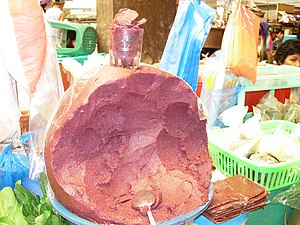
バゴーン・アラマング(フィリピンの様々な言語でアラマング、ウヤップ、ダヨク、ギナモスとも)は、フィリピンのシュリンプペーストである。これはバゴーンの一種で、フィリピン料理における発酵魚介類(発酵魚、カキ、アサリなどを含む)の一種であり、魚醤(パティス)も生産される。インドネシアやマレーシアの品種(フィリピン語/タガログ語でアラマングとして知られる)と同じAcetes種の小エビから作られ、緑色のマンゴー(茹でたサババナナやキャッサバも)の調味料として、主要な調理材料として、またはソテーして白いご飯と一緒に食べられる。バゴーンペーストは、種類によって見た目、風味、辛さが異なる。ピンク色で塩味のバゴーン・アラマングは「新鮮なもの」として販売され、実質的にはエビと塩の混合物を数日間漬け込んだものである。このバゴーンは、未熟なマンゴーのトッピングとして以外は、この形ではほとんど使用されない。このペーストは通常、様々な調味料と一緒にソテーされ、その風味は塩辛いものからスパイシーで甘いものまで様々である。ソースの色も、調理時間やソテーに使用する材料によって異なる。
東南アジアの他の地域とは異なり、スールー諸島、西ビサヤ諸島、ルソン島南東部のビコル地方では、エビが原型を留めないほど発酵させられたり、滑らかな状態に挽かれたりするが、フィリピンの多くの地域におけるバゴーン・アラマングのエビはまだ原型が確認でき、ソース自体も塊状の粘度を持っている。調理またはソテーしたバゴーンは、ひき割りピーナッツで作られた牛テールシチューであるカレカレの付け合わせとして少量添えられる。また、豚肉料理であるビナグーンガン(文字通り「バゴーンが加えられたもの」)の主要な調味料でもある。
バゴーンという言葉は、ボンネットマウスやカタクチイワシから作られるソース、すなわちバゴーン・テロンも指す。
ブロン・ヒポン

バラオ・バラオ、またはブロン・ヒポンは、カパンパンガン料理で使われるシュリンプペーストの一種である。
ブラチャン
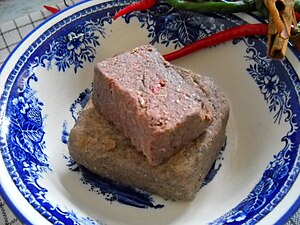
ブラチャンはマレーのシュリンプペーストの一種で、マレーシアではゲラガウ、インドネシアではレボンと呼ばれるAcetes種の小エビから作られる。マレーシアでは、通常、オキアミを最初に蒸し、ペースト状に潰して数ヶ月間保存する。発酵させたエビを調理し、揚げて硬くプレスしてケーキ状にする。イギリスの作家ウィリアム・マースデンは、1812年に出版された彼の著書「マレー語辞典」にこの言葉を含めている。
ブラチャンは多くの料理の材料として使われる。一般的な調理法は、焼いたブラチャンを唐辛子、刻んだニンニク、エシャロットペースト、砂糖と混ぜて揚げるサンバル・ブラチャンである。風味を引き出すために焼かれることもあり、通常は強く特徴的な匂いを放つ。
北オーストラリアでは、サンバル・ブラチャンの一種が地元でブラチャンまたはブラチュン(インドネシア語の発音を音訳したもの)として知られており、ブルーム、ダーウィン、ケアンズのアボリジニやトレス海峡諸島民の家庭で人気がある。その存在は、初期のマカッサル商人の影響によるものとされている。
フィリピンの「新鮮な」バゴーン・アラマング(発酵期間が短い)に似たブラチャンのバージョンは、チンチャロックとして知られている。
スリランカでは、ブラチャンはランプライスを作るために使用される主要な材料である。
バルチャオ
ガルンボは乾燥させた小エビで、乾燥赤唐辛子、スパイス、パーム酢と一緒に挽いてスパイスペーストを作る。これはインドのゴアでバルチャオとして知られる酸味、甘味、辛味のあるソースに使われる。ポルトガル人がゴアにもたらしたもので、マカオが起源である。ピクルスに近く、少量で付け合わせの調味料として使われる。
ハムハ
ハムハ(Chinese: 鹹蝦; Cantonese Yale: hàahm hā; pinyin: xiánxiā)は「hom ha」とも表記され、har cheong(Chinese: 蝦醬; Cantonese Yale: hā jeung; pinyin: xiājiàng)としても知られる。これは中国南東部の料理で人気の細かいエビペーストであり、広東人が定住した多くの場所で主要な調味料となっている。より南で作られるエビペーストに比べて色が薄い。豚肉、シーフード、野菜の炒め物には欠かせないものとされている。匂いと風味が非常に強い。真珠大のハムハがあれば、2人分の炒め物の味付けには十分である。エビペースト産業は香港地域で歴史的に重要であり、香港の工場は世界中のコミュニティにハムハを輸出し続けている。
カピ

タイでは、シュリンプペーストはカピ(Thai: กะปิ);(Lao: ກະປິ)と呼ばれる。タイでは、多くの種類のナムプリック(辛いディップやソース)や、ゲーンソムに使われるペーストなど、すべてのタイカレーペーストに不可欠な材料である。タイで非常に人気があるのは、新鮮なシュリンプペーストで作られ、揚げたプラトゥー(ショートマカレル)や、揚げた、蒸した、または生の野菜と一緒に食べられるナムプリック・カピという辛い調味料である。タイ南部には、エビのみで作られたもの、エビと魚の材料を混ぜたもの、甘いペーストの3種類のシュリンプペーストがある。ナムプリック・メーンダーはハットヤイとサトゥーンの市場で入手できる。カブトガニ(メーンダー)の体液を絞り、カピと混ぜることで、かなり甘い味がする。ナムプリック・マカムは、タマリンド(マカム)と混ぜたカピで、より酸味が強い。
もう一つの一般的なタイの食品はムンクンで、これも紛らわしいことに「シュリンプペースト」と訳されることが多い。ムンクンはオレンジ色で油っぽく、より液状であるのに対し、カピは灰色、薄紫、あるいは黒で、はるかに固く、崩れやすい。ムンクンは実際にはエビの頭の中にある脂肪で、肝臓と膵臓の役割を果たす器官からのものであり、エビのパテまたはフォアグラのようなものである。「シュリンプトマリー」という用語もムンクンに使われることがあるが、デフォルトでは「トマリー」は一般的にロブスターやカニから採取されると想定されており、料理的に全く異なる日本の食品であるカニミソの英語訳にも使われることがある。
マムトム

ベトナムのシュリンプペースト(マムトム、vi)には、とろみのあるペースト状のものと、より液状のソース状の2種類がある。提供する際は、通常、砂糖、ライムジュース、キンカン、唐辛子と混ぜてディッピングソースとして使用される。ベトナムでは、マムトムを茹で肉、揚げ豆腐、揚げ魚のディッピングソースとして、またはブンマムなどのスープ料理の味付けによく使用する。
ンガピ・ヤイ
ミャンマー、特にビルマ族やカレン族の間で非常に人気のある水っぽいディップまたは調味料。ンガピ(魚またはエビ、しかし主に魚全体のンガピが使用される)を玉ねぎ、トマト、ニンニク、コショウ、その他のスパイスと一緒に煮込む。その結果、緑がかった灰色のスープのようなソースができあがり、あらゆるビルマの食卓に並ぶ。新鮮な生野菜、湯通しした野菜、果物(ミント、キャベツ、トマト、青マンゴー、青リンゴ、オリーブ、唐辛子、玉ねぎ、ニンニクなど)をンガピ・ヤイに浸して食べる。時には、あまり裕福でない家庭では、ンガピ・ヤイが主菜となり、主要なタンパク源となることもある。
プティス・ウダン
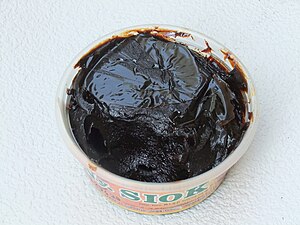
プティス・ウダンは、インドネシア、マレーシア、シンガポールで使われるシュリンプ/プラウンペーストの一種である。インドネシアでは特に東ジャワ州で人気がある。この濃厚な黒いペーストは、ブラチャンのような硬いレンガ状ではなく、糖蜜のような粘度がある。また、砂糖が加えられているため、より甘い味がする。プティスは、エビ加工の残りかすのスラリーを煮詰めて作られる。一般的に、プティスに甘い風味を与えるために糖蜜が加えられる。これは、ポピア春巻き、アサム・ラクサ、チーチョンファン米ロール、そしてルジャック・チンガルやルジャック・プティスなどのルジャックサラダなど、地元の一般的な屋台料理の風味付けに使われる。インドネシアでは、東ジャワ州のシドアルジョ、パスルアン、グレシク地域にある家内工業が主なプティス生産者である。
シドル
バングラデシュのチッタゴン丘陵地帯では、ジュマ族がシュリンプペーストをシドルまたはナッピと呼んでいる。彼らはこれを使ってタケノコカレーなどの野菜料理を作る。このタケノコカレーは、ジュマ族の伝統的な食べ物である。彼らはこの方法で食べる。まず、タケノコを竹林から集め、葉を取り除き、水で茹でる。次に、茹でた水とシュリンプペーストを混ぜる。シュリンプペーストを混ぜた水に、唐辛子、ニンニクペースト、塩、小麦粉を加える。混合物を加熱し、数分後、茹でたタケノコを混合物に乗せ、引き続き加熱する。数分後、料理は提供できる状態になる。
テラシ
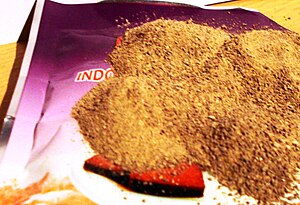
テラシ(Dutch: trassi、Javanese: ꦠꦿꦱꦶ, romanized: trasi)は、インドネシア(特にジャワ)の乾燥シュリンプペーストの一種で、通常は暗いブロック状で売られているが、粗い粒状の粉末としても販売されることがある。テラシの色と香りは、どの村で生産されたかによって異なる。色は柔らかい紫赤色から暗茶色まで様々である。西ジャワ州の沿岸都市チレボンでは、テラシはレボンと呼ばれる小さなエビ(Acetes)から作られ、これが市の名前の由来となっている。もう一つの種類は、エビやマグロをパームシュガーと混ぜて作られるプティスである。シドアルジョ(東ジャワ州)では、テラシは魚、小さなエビ(ウダン)、野菜などの材料を混ぜて作られる。テラシは、サンバルテラシの重要な材料であり、その他多くのインドネシア料理、例えばサユール・アセム(タマリンド風味の野菜スープ)、ロテック(ガドガドとも呼ばれるインドネシア風ピーナッツソースサラダ)、カレドック(ロテックに似ているが、野菜は生で供される)、ルジャック(インドネシア風辛口フルーツサラダ)などにも使用される。
インドネシアのロンボク島では、より風味豊かで甘いシュリンプペーストレンカレが作られている。
産業
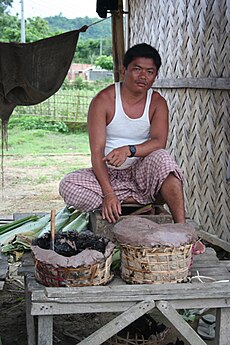
シュリンプペーストは、現在も沿岸部の漁師の家族によって作られている。彼らはそれを行商人、仲買人、または流通業者に販売し、彼らが消費者への再販のために包装する。シュリンプペーストは、製造技術と品質が村ごとに異なるため、産地で知られることが多い。インドネシアのリアウ州バガンシアピアピ、西ジャワ州インドラマユ、チレボン、東ジャワ州シドアルジョなどの一部の沿岸地域や、マレーシアのプラウ・ベトン、香港の馬湾島、フィリピンのパンガシナン州リンガエン湾などの村は、非常に高品質なシュリンプペーストの生産でよく知られている。
調製方法
調製方法は大きく異なる場合があるが、中国や東南アジアの大部分では以下の手順が最も一般的である。
漁獲された小エビは、まず陸揚げされ、水洗いされて水気を切ってから乾燥される。乾燥は、地面に敷いたプラスチックマットの上で天日干しにするか、低い高床式の金属台の上で行うか、または他の方法を用いる。数日後、エビと塩の混合物は黒ずんで濃厚なパルプ状になる。ペーストの製造に使用されたエビが小さい場合は、個々のエビが認識できないほど分解されればすぐに提供できる状態になる。エビが大きい場合は、発酵に時間がかかり、パルプはより滑らかな粘度にするために粉砕される。この発酵と粉砕のプロセスは、ペーストが完全に熟成するまで数回繰り返されるのが一般的である。その後、ペーストは乾燥され、村人によってブロック状に切られて販売される。乾燥したシュリンプペーストは冷蔵を必要としない。
入手性
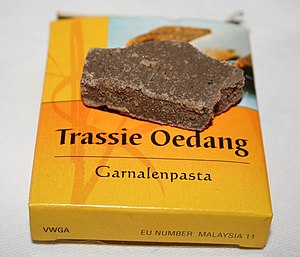
シュリンプペーストは、東南アジア以外の国でも、アジア系顧客向けの市場で手に入れることができる。オランダでは、コニマックス社のTrassie Oedangなど、アジア食品を販売するスーパーマーケットでインドネシア風シュリンプペーストを見つけることができる。アメリカでは、PantainorasinghやTra Changといったタイのシュリンプペーストのブランドが見られる。他の国のシュリンプペーストもアジア系スーパーマーケットや通販で入手可能である。また、ジャワ系住民が多いため、スリナムでも容易に入手できる。オーストラリアでは、シュリンプペーストは東南アジア出身の人々が多く住むほとんどの郊外で見つけることができる。
関連項目
外部リンク
 Media related to Shrimp paste at Wikimedia Commons
Media related to Shrimp paste at Wikimedia Commons- タイのエビペースト Kasma Loha-unchit in Dancing Shrimp:シーフードのお気に入りのタイのレシピ。
| この記事は、クリエイティブ・コモンズ・表示・継承ライセンス3.0のもとで公表されたウィキペディアの項目Shrimp paste(8 April 2025, at 18:49編集記事参照)を翻訳して二次利用しています。 |

